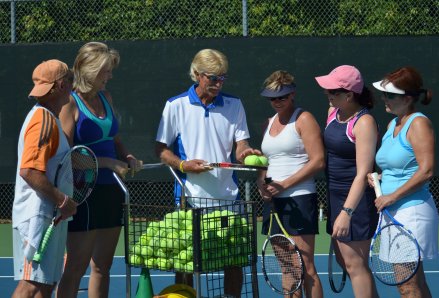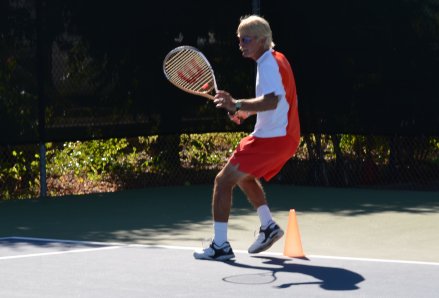 |
| |
 Frequently Asked Questions Frequently Asked Questions |
 |
-
 What is NTRP ratings? What is NTRP ratings?
NTRP Stands for National Tennis Rating Program and is a general description of what defines a player’s skills or level of play. The ratings help the players find other players of approximately the same level to compete with, play on a team with and to practice with to get to the next level.
-
 How do I use NTRP ratings to get better? How do I use NTRP ratings to get better?
Players have an automatic "lesson plan" to get better by looking at the description of what the next level player can do. Working with your pro - you have a game plan to improve your skills and tactics over a period of time.
-
 How does NTRP affect USTA League Play? How does NTRP affect USTA League Play?
Players create a team based upon the same skill level or mixed skill levels or mixed gender levels. There are seasons when players make teams of the same skill level, mixed skill levels and mixed genders (mixed doubles). These seasons are determined by the USTA with times when captains need to register a team with the USTA and once that is done, players can begin to register on that team to compete against other teams.
-
 How do I become a member of the USTA? How do I become a member of the USTA?
Go to the www.Norcal.usta.com web site and click on register to become a member of the USTA for a year or more. If you have previously played league tennis with the USTA you will have a USTA - NTRP based rating. If this is your first time you will be directed to go to a part of the site to "self rate" based upon suggested criteria to "get in the game".
|
|
 |
| |
|
 |
 At What Level Do You Play? At What Level Do You Play? |
 |
NTPR Self Assessment
- Step 1. Begin with level 1.5. Read all categories carefully and then decide which one best describes your present ability level. Be certain that you qualify on all points of all preceding levels as well as those in the level you choose.
- Step 2. When rating yourself assume you are playing against a player of the same gender and the same ability.
|
 |
 |
NTPR Playing Levels
- 1.5 You have limited experience and are working primarily on getting the ball in play.
- 2.0 You lack court experience and your strokes need developing. You are familiar with the basic positions for singles and doubles play.
- 2.5 You are learning to judge where the ball is going, although your court coverage is limited. You can sustain a short rally of slow pace with other players of the same ability.
- 3.0 You are fairly consistent when hitting medium-paced shots, but are not comfortable with all strokes and lack execution when trying for directional control, depth, or power. Your most common doubles formation is one-up, one-back.
- 3.5 You have achieved improved stroke dependability with directional control on moderate shots, but need to develop depth and variety. You exhibit more aggressive net play, have improved court coverage and are developing teamwork in doubles.
- 4.0 You have dependable strokes, including directional control and depth on both forehand and backhand sides on moderate-paced shots. You can use lobs, overheads, approach shots and volleys with some success and occasionally force errors when serving. Rallies may be lost due to impatience. Teamwork in doubles is evident.
- 4.5 You have developed your use of power and spin and can handle pace. You have sound footwork, can control depth of shots, and attempt to vary game plan according to your opponents. You can hit first serves with power and accuracy and place the second serve. You tend to over-hit on difficult shots. Aggressive net play is common in doubles.
- 5.0 You have good shot anticipation and frequently have an outstanding shot or attribute around which a game may be structured. You can regularly hit winners or force errors off of short balls and can put away volleys. You can successfully execute lobs, drop shots, half volleys, overhead smashes, and have good depth and spin on most second serves.
- 4.5 You have developed your use of power and spin and can handle pace. You have sound footwork, can control depth of shots, and attempt to vary game plan according to your opponents. You can hit first serves with power and accuracy and place the second serve. You tend to over-hit on difficult shots. Aggressive net play is common in doubles.
- 5.0 You have good shot anticipation and frequently have an outstanding shot or attribute around which a game may be structured. You can regularly hit winners or force errors off of short balls and can put away volleys. You can successfully execute lobs, drop shots, half volleys, overhead smashes, and have good depth and spin on most second serves.
- 5.5 You have mastered power and/or consistency as a major weapon. You can vary strategies and styles of play in a competitive situation and hit dependable shots in a stress situation.
6.0 to 7.0 You have had intensive training for national tournament competition at the junior and collegiate levels and have obtained a sectional and/or national ranking.
- 7.0 You are a world-class player.
|
 |
|
 |









